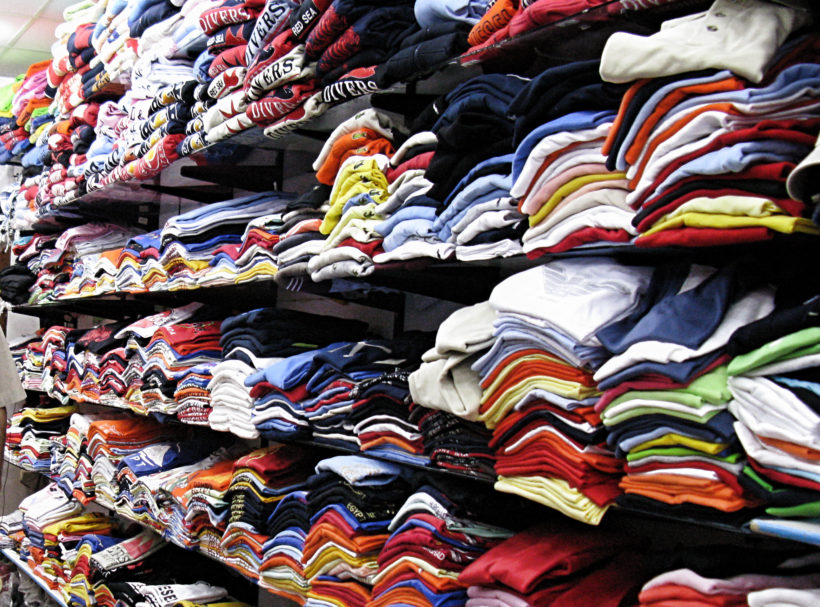 By MIRIAM ACZEL
By MIRIAM ACZEL
Our consumption and use of resources arguably need a rethink: Earth Overshoot Day, the date when our resource consumption for the year surpasses the Earth’s capacity to regenerate those resources, is occurring earlier and earlier. This means that global consumption levels are unsustainable. The fashion industry in particular is a key driver of resource consumptions: the overproduction and overconsumption are crucial issues for the industry, and consumers have an increasing demand for ‘fast fashion.’ New research showsthat the average person today buys 60% more clothing items than 15 years ago—and we keep clothing items for less than half as long.
Growing Environmental Footprint
The clothing industry’s impact on carbon emissions is projected to grow by nearly 50% by 2030. Moreover, the number of ‘fashion cycles’ for production of clothing has risen from only two per year to as many as 50-100cycles. Because of this, clothing brands are producing more, and consumers are both buying and throwing clothes at a record speed, with increasing amounts of items ending up in landfills.
The clothing industry also consumes large amounts of water: for example, it takes over 700 gallons of water to make one cotton t-shirt, and nearly 2000 gallons of water are used to make one pair of jeans.
However, there is clear power in collective action, and we as consumers have the potential to remedy this problem by moving towards a circular economy, where we extend the lifetime of resources and goods as long as possible. By changing perceptions of what we need in our closets and improving our understanding of how our purchase habits affect the environment, we can collectively move towards a circular economy, in which we keep resources in use for as long as possible.
Reduce, Reuse, Recycle
As consumers are increasingly aware of the high environmental costs of the fashion industry, more sustainable brands and projects are developing solutions to increase recycling of materials and promote a more circular industry, reducing the billions of tons of clothing that ends up in landfills every year. Sustainable brands and other circular solutions also reduce the massive amounts of water, land and energy currently used in clothing manufacture.
Reducing Fashion Waste Through Resale and Rentals
Over 26 billion pounds of clothing and household items end up in landfills every year—and of that, over 95 percent of can be reused or recycled. Consumers may have the power to make an important difference through reusing items. For example, Savers,one of the largest thrift store chains in North American, is working not only to provide secondhand items at a low cost, but to help change the way consumers think about sustainability and reuse. The company’s Rethink Reuse program has focused on raising public awareness and understanding of reuse through activities such as interactive art installations in Seattle, Vancouver, and Toronto, in order to better educate consumers about problems related to textile waste. Another sustainable solution is the increasing trend towards of fashion rentals, which also helps to reduce the amount of clothing items that end up in landfills.
Circular Fashion Around the World
As increasing numbers of consumers take a stance on environmental and social costs of fashion purchases, companies are responding with innovative and creative solutions. The notion of circular fashionseeks to close the loop by reusing and recycling waste, rather than the typical linear model of the fashion industry. In March, Australia will be hosting the second Australian Circular Fashion Conference (ACFC), in order to provide more opportunities to develop and invest in fashion-industry sustainability. The Conference was established in 2018, and led to a new association, the Australasian Circular Textile Association(ACTA)to respond to conference attendees’ requests for assistance in moving from a linear business model to a circular one.
India’s first Circular Design Awardswill be held during Lakmé Fashion Week (LFW). The Circular Design Awards will showcase 8 fashion labels, brands chosen from nearly 1000 applicants across India. These brands demonstrate their commitment to integrate circular design principles throughout all stages of their business operations, from using environmentally-friendly fabrics and product packaging to having guidelines for recycling of used clothing.
Similarly, Hong-Kong-based NGO Redress just opened the 9th iteration of the Redress Design Award—the largest global sustainable fashion competition. Currently, the fashion industry recycles under 1% of materials used in clothing production, corresponding to a loss of over $100 billion of materials wasted each year. However, roughly 80% of a clothing item’s environmental impact is defined at the design stage, so fashion designers can enact change. As the world’s largest textile and clothing exporter, and currently the world’s largest fashion market, China has an important rolein making a difference in reducing the global impacts of the fashion industry.
Sustainable Design Resources
Just last week, the Council of Fashion Designers of America (CFDA) launched a brand new sustainability initiative to help fashion brands make the transition to a more environmentally-friendly supply chain. The goal of the CFDA’s initiative is to facilitate understanding and implementing sustainability for all designers, through a wide variety of resources and published research. The CFDA also released a new report, which asserts that improving your manufacturing and promoting positive environmental and social impact doesn’t mean sacrificing fashion. Rather, the report argues that sustainable business solutions are built from the ground up:
“Sustainability is great design… It is based on a deep understanding that all things are interconnected in this world. Sustainability provides the ability to design and produce indefinitely. This requires that the design, development, production and use of fashion products meet today’s needs – without preventing those needs from being met by future generations.”
Positive Changes Ahead?
It’s clear that there are changes occurring in the industry, from design-level rethinking and restructuring, to consumers demanding more accountability and transparency in brands. Beyond making a commitment to purchasing secondhand and increasing the functional lives of our goods, another important way consumers can take action to promote more sustainable fashion practices is though raising awareness and increasing our knowledge about different brands and their production processes. The app Good On You, for example, rates clothing labels based on the social, environmental, and animal costs of their production, and highlights companies without transparency in their supply chain operations. In today’s increasingly interconnected digital world, the demand for transparency is increasing, and hopefully will lead to great strides in reducing waste from industries like the global fashion industry.
As stated in the new CFDA Sustainability Initiative, “Now is a truly exciting time for the sustainability movement in fashion… We have the power to change the way fashion is made and consumed.”
Read more about sustainable fashion in the CFDA’s Sustainability Resources.
Want to learn more about sustainable solutions and the circular economy? Join Leaders in Energy’s Circular Economy Working Group, which meets on the 4th Wednesday of every month!
Miriam Aczel is a President’s Scholar PhD Candidate at Imperial College London’s Centre for Environmental Policy. Her research focus is on international energy science and policy, with a focus on mitigation of environmental and health impacts of shale gas. She is also co-founder and co-director of the Amir D. Aczel Foundation for Research and Education in Science and Mathematics, a nonprofit working in Cambodia.
Miriam is Director of Communications and blog editor for Leaders in Energy.



Leave a Reply